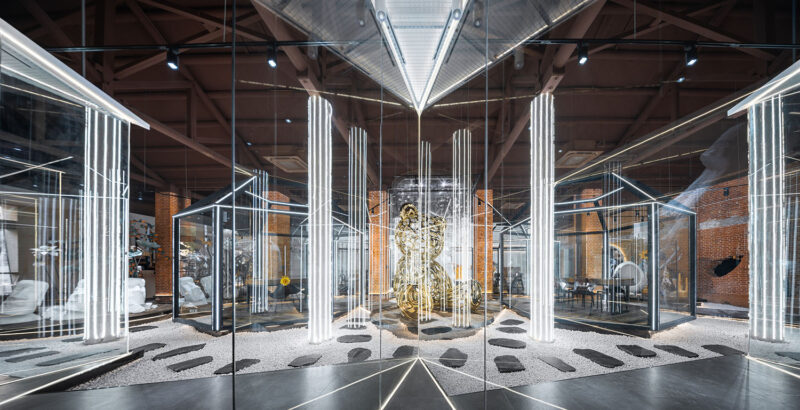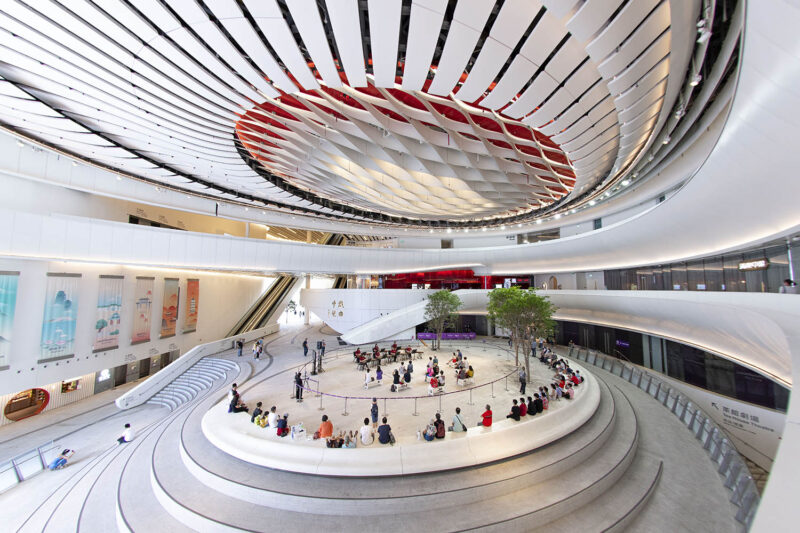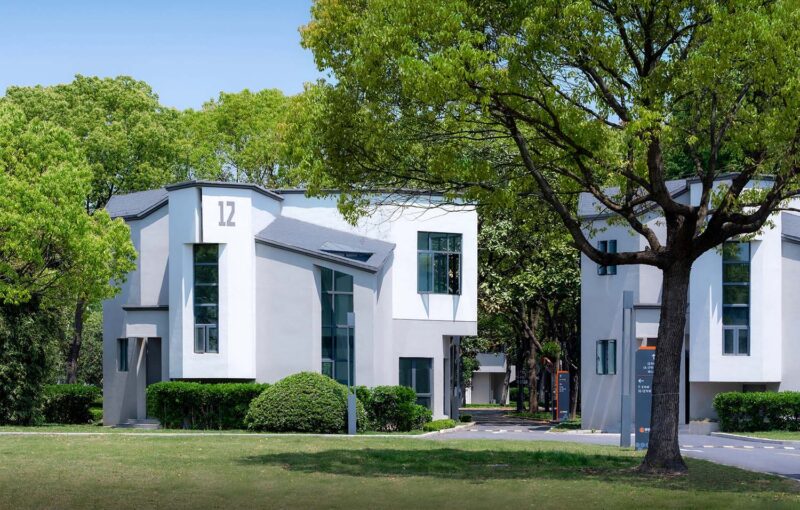全球设计风向感谢来自AAI-Monster Lab的公共空间项目案例分享:
定义:天府“舞台”
Definition: Tianfu “Stage”
AAI国际建筑事务所新锐创意工作室Monster Lab在全国竞赛中赢得了成都招商天府新区城市规划展览馆项目。作为整个片区最先落成的展览馆暨先行示范项目,展览馆将见证着城市新区何以从一片荒芜走向高楼林立、经济蓬勃、文化多元的未来。
Monster Lab, the new creative studio of AAI International Architecture, won a national design competition for the Chengdu Merchants Urban Planning Exhibition Hall in the New District of Tianfu. As the first exhibition hall and demonstrative project to be built in Tianfu, the project will bear witness to the new area’s progression from empty fields to an economically prosperous urban district, characterized by new skyscrapers and a culturally diverse populace.
“提炼最传统、表达最未来”,我们希望这座以“展示”为使命的建筑能兼容成都的文化过往,对话城市发展的“可能未来”。
Through “refining traditional achievements and expressing future excellence”, we hope that this building, with its mission of showcasing the district’s timeline, will be compatible with Chengdu’s cultural past and speak to the future possibilities of urban development here.
“舞台”的概念由此而来。今日的中国,新城林立如雨后春笋,每一座城市都标榜着最前沿的城市理念。但是这座新城的根在哪里?我们决定从老城中寻找答案。
The concept of “stage” came from the fact that in today’s China, new cities are springing up everywhere, with each one advertised as being at the forefront of urban planning concepts. But where is the root of these new cities? We decided to find the answer in the ancient city.
建筑的框架脱胎于老成都常见的公共建筑——戏台。巷道中央,飞檐之下,舞台空间和架空空间上下相叠,它与城市、与人形成双重互动:表演性与参与性(“舞台空间”是演出的容器,而“架空空间”则保证了道路的通达性)。
The framework of the building was born out of the theatre, a common public building type in old Chengdu. Typically in these theatres, in the middle of the laneway, under its eaves, the stage space and the overhead space overlap with each other. This forms a dual interaction with the city and spectators: performance and participation (the “stage space” acts as the container of the performance, while the “overhead space” ensures the road below is easily accessible).
我们对该元素抽象演绎,用现代的视觉语言来还原这一空间结构。应业主需求,建筑被均等地划分为三个体量,分别展示未来规划、未来商业和未来生活。在三重体量的交汇点,我们以一座共享的灰空间扣题“天府舞台”,它依照“舞台空间”、“架空空间”的结构逻辑,将人引至舞台,眺望新城的瑰丽。
We have abstractly interpreted these elements and incorporated a contemporary visual language to renew this spatial structure. In response to the needs of the client, the building has been equally divided into three volumes to exhibit future planning, future business, and future life, respectively. At the intersection of the three volumes, we have designed a shared space called the “Tianfu Stage”. It draws people in and through to overlook a magnificent view of the new city, in accordance with the structural logic of the “stage space” and “overhead space”.
同时,置身舞台之中,观看风景的人亦成为“舞者”,被建筑之外的风景所观看。一座市民展望厅叠加于“舞台”之上,在建筑的制高处“展望”方能更高、更远。
At the same time, people watching the scenery from the “stage” also become “dancers”, being potentially seen from the landscape outside the building. A public observatory has been placed overtop the “stage”, allowing visitors to see higher and farther from the commanding heights of the building.
场所回应:景框
Site Response: Frame
“城市是一个‘生态系统’,建筑是其中栖息的动物或植物。”在Monster-LAB的设计哲学中,建筑应当具备生命力,像一棵树一般扎根,吸收场所予以的“阳光、空气和养分”,生长出独一无二的面貌。“天府舞台”的设计正是如此。
“A city is an ‘ecosystem’ in which the buildings are the animals or plants inhabiting it.” In Monster Lab’s design philosophy, architecture should have vitality, take root like a tree, and absorb the “sunlight, air, and nutrients” of the place, in order to give growth to a unique appearance. This is exactly the approach taken for the design of the Tianfu Stage.
项目所在地东迎CBD的人字形景观绿廊,西望塔楼群城市景观,视野极佳。置身风景,我们首先依循视线,对各功能体量进行旋转、折叠,定位出人与景的相对关系。建筑之于观看行为的意义,正如画框之于画——约束一个边界,引人聚焦最精华的内容。新城的风景是流动的,为它“裱框”,我们希望预演其未来的形态,并与之产生呼应和互动,共同生长。
我们完全依循规划中的城市天际线的形态来约束三组建筑体量的倾角,在“舞台”的景框中,见证天际线随城市的发展而逐步“完形”。这是一座无法腾挪位置的建筑,所有的逻辑皆顺应风景的在场、人的在场。
As the project is located east of the CBD (Central Business District) within a green landscape corridor, the site provides an excellent view of the complex cityscape of towers to its west. Taking the pre-existing landscape into account, our design process first assesses existing sightlines, and then rotates and folds each functional volume, in order to arrive at the ideal relationship between people in and around the building, and the scenery surrounding it. Architecture is about defining viewing opportunities and behavior, just as painting is about frames – constraining a boundary and drawing attention to the most essential content. The scenery of the new city is fluid. In “framing” it, we hope to preview its future form, echo and interact with it, and grow together.
We closely follow the planned form of the urban skyline to constrain the height and overall dimensions of the three building volumes. Within the frame of the “stage”, we may witness both the city and the skyline gradually developing into a comprehensive whole, in which the “stage” will be an active part. This is a building derived from and rooted in its place: its design logic is adapted to align with the presence of the surrounding scenery, and the presence of people.
建筑在立面处理上同样以视野为优先:东西两个景观面向较好的地方以大面积玻璃幕墙包裹,而在南北两向则覆以实墙。虚实相生,以“虚”观景,以“实”摒弃冗余的干扰,让视线再度聚焦。
The building also prioritizes visitors’ field of vision in regards to its facade treatment: the areas with better east and west views are clad with large glass curtain walls, while the north and south walls are solid. While the virtual and real coexist, the design suggests a temporary abandonment of redundant interference, allowing the “real” to take priority and letting one’s attention/ line of sight to be focused again.
成都是一座休闲、享乐颇为盛行的城市,其独特的气候条件让室外空间具备市井生活的潜力。在“天府舞台”,我们依托南向实墙体与场地预留的景观空间,设计一座户外影院,为人们提供多维度、多场景的参与可能,为建筑、为成都未来注入面向未来的新血脉。
Chengdu is a city where recreation and enjoying the pleasures of life are commonplace, and its unique climate makes its outdoor spaces particularly well suited for leisurely activities. In the “Tianfu Stage”, we designed an outdoor cinema based on the south-facing solid wall and the landscape space adjacent to it – providing visitors and viewers with multiple participation possibilities, injecting new energy and potential into the architecture and the future development of Chengdu.
愿景:拉开“帷幕”
Vision: Pull back the “Curtain”
凡有舞台,必有帷幕。它代表一种“开始”的临界状态:帷幕未升,灯光晦暗,沉寂无声;帷幕拉起,舞台之中上演的一切将人牵引至一种似真似幻的沉浸体验。“天府舞台”立足一座城市革故鼎新的原点,自然也有它的“帷幕”。
Where there is a stage, there will also be a curtain. It represents a pivotal state of “beginning”: the curtain has not yet risen, the lights are dim, and there is no sound; when the curtain goes up, everything that unfolds onstage draws people into a vivid experience, seemingly real and completely immersive. “Tianfu Stage” is based on a new origin of the city, so naturally it follows it also has a “curtain”.
“舞台”的两侧,层层褶皱的玻璃立面便是它的“帷幕”。其折叠形态呼应着成都特色川剧变脸的折扇,独特的拼接角度让反射到窗面的景色被打碎,形成万花筒般的戏剧效果,让空间亦能“变脸”,予人以惊喜。
On either side of the “stage”, folded glass façades act as its “curtain”. Their folding forms echo the face-changing folding fan of Chengdu’s characteristic Sichuan Opera. The unique shifting angles of the façades breaks up the scenery reflected on the glass, producing a dramatic kaleidoscope-like effect, allowing the space to “change face” and create surprising patterns for visitors walking past.
除此之外,向内倾斜的悬挑玻璃立面形成生态自遮阳系统,室内无需窗帘,一年四季皆可自由地拥抱眼前的景致,我们以设计回应着公园城市的生态概念。
In addition, the inwardly inclined cantilevered glass façade forms an ecological self-shading system. There is no need for curtains on the interior, giving people within a free, unencumbered view of the scenery around the building all year round – furthering our intent to have the design take its place within the ecological concept of the park city.
如今,“天府舞台”已被交还城市、公众与时间,它将作为片区重要的公共空间,扮演一座真正的“舞台”——静待被室内设计填满,被人的行为焕活,被社会生活与集体记忆重塑,被景观与城市的“生长”赋予不同的面貌……空间的设计完成于此,设计的价值与时间共长。
Today, the “Tianfu Stage” has been returned to the city, the public, and time. It will serve as an important public space in the area, acting as a real “stage”- waiting to be filled with interior design, and rejuvenated by human activity and society. Urban life and collective memory are reshaped by the project, given different faces by the growth of the city and landscape… The design completes the space here, with all of its aspects realized to ensure long lasting value to the city and its populace.
∇ 东西立面图
∇ 南北立面图
∇ 剖面图
∇ 总平面图
∇ 分析图
项目信息
项目名称:成都招商天府新区城市规划展览馆
项目地点:四川省成都市天府新区天府公园雅州路边
项目状态:已建成
设计公司:AAI-Monster Lab
深化设计:CSWADI中建西南院
项目总监:孙青、金文倩
主创建筑师:赵振富、王涵、余嵩
设计团队:余嵩、方洁、崔兆旻,吴先发,王海英、魏婉,陈勇强,吴星远,薛梅卿
项目类型:建筑设计
设计周期:2019.10 – 2020.4
建造周期:2020.0 – 2020.12
场地面积:17,929㎡
建筑面积:9017.5㎡
室内面积:9017.5㎡
业主及投资方:招商蛇口成都公司
玻璃幕墙:信义玻璃
电梯:通力电梯
钢构:一宇钢构
造价:约1亿人民币
撰稿人:白雅舒
摄影:xf photography、釋象萬合、栾祺
Name of the Project: Chengdu Merchants Urban Planning Exhibition Hall in the New District of Tianfu
Project Location:Yazhou Road, Tianfu Park, Tianfu New District, Chengdu City, Sichuan Province
Project Status: Built
Architecture Design: AAI – Monster LAB
Development & ConstructionDesign:CSWADI
Principle Architects: Zhenfu Zhao, Han Wang
Project Director: Daniel Sun, Carol Jin, SongYu
Design Team : Song Yu、Jie Fang、Zhaomin Cui、Xianfa Wu、Haiying Wang、Wan Wei、Yongqiang Chen、Xingyuan Wu、Meiqing Xue
Project Type: Architecture Design
Design Period: 2019.10 – 2020.4
Construction Period: 2020.0 – 2020.12
Site Area: 17,929sqm
Gross floor area (m2):9017.5㎡
Interior space area (m2):9017.5㎡
Client & Investor: (CMSK)
Glass facade: Xinyi Glass
Lift: KONE Elevator
Steal structure: YIYU STEEL STRUCTURE
Total Budget: 100 Million RMB
Article Author: Susanna Bai
Photography: xf photography,INTERPRETATION & SUBLIMATION,LUAN








































